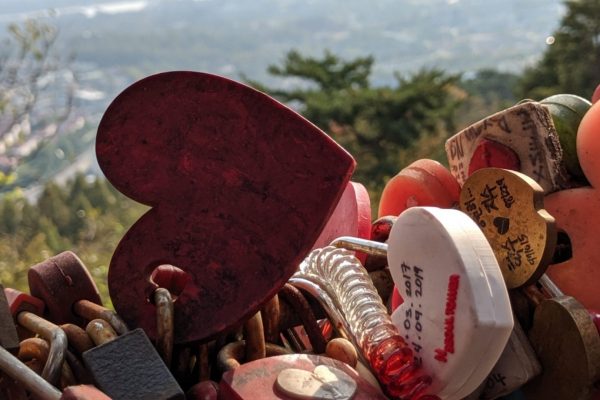You might have seen it on temples, palaces, or other historic structures: Dancheong / 단청. It refers to traditional Korean decorative coloring or painting, characterized by vibrant and multicolored patterns that often include various geometric shapes, floral motifs, and symbolic representations. Let’s take a deep dive into the meaning behind this art! And look at some recommendations on where to see it in Seoul, Suwon, and Daegu!

Dancheong in a nutshell
First of all: Dancheong serves both aesthetic and practical purposes. Aesthetically, it adds a distinctive and colorful touch to architectural elements, enhancing the overall visual appeal of the structures. Practically, it also serves as a protective coating for wooden surfaces, helping to preserve the buildings by shielding them from the elements.
The use of Dancheong has a long history in Korea, dating back to ancient times. It has been employed in the construction and decoration of religious and royal buildings, reflecting the cultural and artistic traditions of the Korean people. Also, the colors used in Dancheong are often symbolic, with each hue holding specific meanings related to traditional Korean cosmology and beliefs.
In contemporary times, Dancheong continues to be appreciated and preserved as part of Korea’s cultural heritage. Restoration efforts on historic buildings often involve the careful recreation or conservation of Dancheong to maintain the authenticity and beauty of these structures.

A trip down history lane
Dancheong has roots dating back to the ancient Goguryeo/고구려 Kingdom era (37 BCE-668 CE). Used in architecture, painting, sculpture, and crafts, it adorned sacred places like temples and palaces, adding vibrant colors and intricate patterns to their designs. The art served practical purposes, covering flaws in buildings and offering protection against elements and pests.
During the Joseon Dynasty, Dancheong evolved into a distinctly Korean style, characterized by bright colors and diverse motifs.
The meaning behind the colors
Unlike neighboring countries such as China and Japan, Korea embraced a diverse palette of colors, each representing elements fundamental to the universe according to the Yin and Yang philosophy and the Five Elements Theory.
The five cardinal colors blue, red, yellow, white and black represent wood, fire, earth, metal and water, respectively. Each hue was strategically placed on buildings to harmonize with nature: reddish tones typically towards the bottom of a building and greenish tones towards the top, mirroring the colors of a tree.
Geometric patterns were prevalent in Dancheong, often arranged in continuous designs known as Geummun/금문, resembling the weaving of silk threads. These patterns varied depending on historical and political contexts, as well as the preferences of the artisan. Motifs depicted flora and fauna, such as lotuses, pomegranates, and peonies, symbolizing wishes for prosperity, fertility, and longevity.
Where to see Dancheong
Not gonna lie: If you keep your eyes peeled, you can spot Dancheong at many places all over South Korea. So, here’s just a selection of some of my favorite places in Seoul, Suwon, and Daegu to marvel at the Korean traditional art:

Seoul
- Gyeongbokgung/경복궁: The biggest of the Five Grand Palaces and the main royal palace of the Joseon dynasty.
- Deoksugung/덕수궁: Also one of the Five Grand Palaces, but in addition to the traditional palace buildings, it also has western style gardens and fountains.
- Sungnyemun Gate/숭례문 or Namdaemun/남대문: One of the Eight Gates of Seoul, located close to Seoul Station. Don’t forget to look up – the ceilings are stunning!

Suwon
- Suwon Hwaseong/수원 화성: A fortress that used to encircle the entire city. Listed as a UNESCO World Heritage Site.

Daegu
- Gyeongsang-Gamyeong Park/경상감영공원: A beautiful park in central Daegu (Jung District) where you can marvel at Dancheong. Also, you can find traditional clay jars called Onggi/옹기, in which traditionally, Kimchi was stored.
- Dalseong Park/달성공원: The park was once a fortress location of Dalgubeol, a tribal country of the Three Kingdoms Era.
Dancheong today
You can obviously still observe it at the palaces, parks, gates, and other landmarks today (the preservation mostly worked!). But did you know that you can also take it home with you?
There are various brands using Dancheong nowadays. For clothing, wall art, accessories, and more. But the design is especially popular for souvenirs such as pencils and key rings. You can find examples for that in the Korea Cultural Heritage Foundation store.
Have you checked out Dancheong yet? If yes, what’s your favorite place to do so?
Interested in learning more about Korean culture? Check out my blog posts about the best souvenirs to bring, finding pop-up stores, making your own DIY souvenirs, Korean Culture with a Twist, Lotus Lantern Festival, and Traditional Children’s Games as seen on Squid Game.
Also, on my blog, you can find a post on 5 must-download apps before your trip to South Korea as well as a free printable travel prep checklist.
Are you traveling to South Korea?
Get your eSIM via Saily* to have unlimited data while on vacation and check out NordVPN* to stay protected online or watch your Netflix shows available in your home country. 😉
*Affiliate link: I get a commission if you decide to make a purchase through my links, at no additional cost to you. 🙂
Auf Deutsch, bitte? Hier gibt’s den Blog-Post auf Deutsch.



